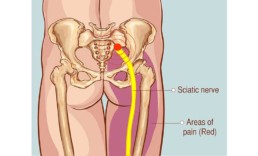We’ve all heard people say it, no matter how impolite it may sound, “What a pain in the butt!” However, anyone who is suffering from piriformis syndrome can make that exclamation literally: Piriformis syndrome actually can cause your buttocks to hurt.
What is Piriformis Syndrome?
Piriformis syndrome refers to the irritation to the sciatic nerve caused by the piriformis muscle.
The sciatic nerve is the body’s longest nerve, running from the base of the spine to the feet. The piriformis muscle extends from your sacrum, the triangle-shaped bone between your hipbones, across your sciatic nerve to the top of your femur, the large leg bone running from hip to knee.
This muscle helps you move your leg from side to side. When it spasms, it can put pressure on the sciatic nerve and result in a variety of symptoms.
Therefore, piriformis syndrome is actually a form of sciatica, the blanket term for any irritation of the sciatic nerve. Harvard University researchers say it is estimated that five per cent of all sciatica cases can be attributed to piriformis syndrome.

How do you treat Piriformis Syndrome?
You may find relief from pain through over-the-counter non-steroidal anti-inflammatory medications such as ibuprofen or naproxen. You can also alternate applications of ice and heat to the area in 15-minute segments, repeated every few hours to relieve your pain.
If the piriformis syndrome doesn’t disappear on its own, which it often does, the next stop is physiotherapy. Your physiotherapist will recommend a course of exercise and stretching, the mainstays of treatment for piriformis syndrome.
The physiotherapist may focus on such treatments as
- adjusting your gait;
- exercises to stretch the muscle and those surrounding it;
- improving the mobility of your sacroiliac joints;
- strengthening your hip abductor muscles, those that move your leg outward;
- acupuncture.
If your ailment doesn’t respond fully to such treatments, you may need an injection of corticosteroids to reduce muscle inflammation. An ultrasound, X-ray or other scan will help determine the proper site for such an injection to be effective.
You may also receive a transcutaneous electrical nerve stimulator treatment where a handheld device is used to send electrical charges through your skin to interrupt pain signals to the brain. In severe cases, which are very rare, surgery may be required.
What is the main cause of Piriformis Syndrome?
Piriformis syndrome can occur for a variety of reasons, including:
- prior hip surgery;
- injury;
- abnormal alignment of the spine, e.g., scoliosis;
- prolonged periods of sitting, especially if you have a wallet in your back pocket;
- a piriformis muscle or sciatic nerve that has developed abnormally;
- a discrepancy in the length of your legs;
- foot problems;
- a direct hit while playing a sport;
- a wound that reaches all the way to the muscle;
- overuse from frequent repetitive exercise, such as running;
- a change from a sedentary lifestyle to a more active one.
Symptoms of Piriformis Syndrome
Initially, piriformis syndrome may appear to be hip bursitis or a herniated disc. A catalogue of symptoms during diagnosis should make it clear to your physician that the cause of the sciatic pain is piriformis syndrome.
Individuals suffering from piriformis syndrome will have:
- trouble putting weight on one side of the buttocks;
- spasms of the piriformis muscle;
- sciatica-type pain if the hip is rotated outward when there is resistance;
- piriformis muscle pain during a rectal exam;
- difficulty sitting for long periods of time;
- pain that increases the longer you sit;
- leg and buttocks pain that increases when you are active;
- tingling or numbness in the buttocks that extends down the back of the leg.
People who sit for long periods of time on the job or at home are at risk for piriformis syndrome, as are people who regularly do rigorous lower-body workouts.
Can MRI detect Piriformis Syndrome?
Although your physician may diagnose piriformis syndrome simply based on your symptoms, he or she may also order tests to support the diagnosis. Two that have proven useful are magnetic resonance imaging (MRI), which looks for nerve inflammation, and the FAIR test (flexion, adduction and internal rotation), which stretches your hip and puts pressure on the sciatic nerve.
The test measures the delay in sciatic nerve signals during muscle compression. An MRI can also help your physician to rule out arthritis or a ruptured disc as causes of the pain.
Prevention
The stretching exercises suggested by your physiotherapist to ease your pain are also good exercises to use regularly to prevent piriformis syndrome from recurring. You should also develop good form for any repetitive motion tasks you perform regularly; consult with your physiotherapist. In addition, don’t undertake exercise that involves the injured muscles until they have healed and practise good posture, which includes wearing shoes that fit well.
